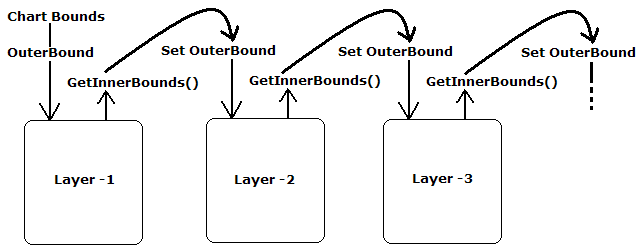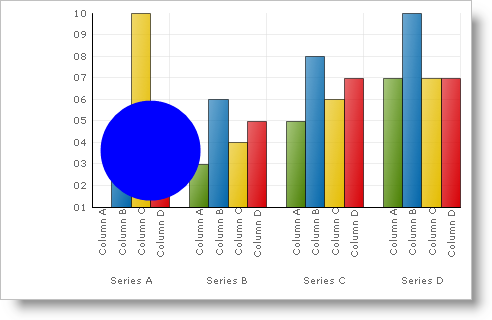
A custom layer class must implement the ILayer interface. This can be done by inheriting UltraChart.Core.Layers.Layer , or by implementing the interface directly.

To implement ILayer, create private fields to store properties, and set/return them in the public properties contained in the interface:
In Visual Basic:
Imports System.Collections
Imports Infragistics.UltraChart.Core.ColorModel
Imports Infragistics.UltraChart.Core
Imports Infragistics.UltraChart.Core.Layers
Imports Infragistics.UltraChart.Core.Primitives
Imports Infragistics.UltraChart.Data
Imports Infragistics.UltraChart.Resources
Imports Infragistics.UltraChart.Resources.Appearance
Imports Infragistics.UltraChart.Resources.Editor
Imports Infragistics.UltraChart.Shared.Styles
Imports Infragistics.UltraChart.Core.Util
...
Public Class MyLayer
Implements ILayer
Private _chartCore As ChartCore
Public Property ChartCore() As Infragistics.UltraChart.Core.ChartCore _
Implements Infragistics.UltraChart.Core.Layers.ILayer.ChartCore
Get
Return Me._chartCore
End Get
Set(ByVal Value As Infragistics.UltraChart.Core.ChartCore)
Me._chartCore = Value
End Set
End Property
' Other interface members omitted
End Class
In C#:
using System.Collections;
using Infragistics.UltraChart.Core.ColorModel;
using Infragistics.UltraChart.Core;
using Infragistics.UltraChart.Core.Layers;
using Infragistics.UltraChart.Core.Primitives;
using Infragistics.UltraChart.Data;
using Infragistics.UltraChart.Resources;
using Infragistics.UltraChart.Resources.Appearance;
using Infragistics.UltraChart.Resources.Editor;
using Infragistics.UltraChart.Shared.Styles;
using Infragistics.UltraChart.Core.Util;
...
public class MyLayer : ILayer
{
private ChartCore _chartCore;
public ChartCore ChartCore
{
get
{
return _chartCore;
}
set
{
_chartCore = value;
}
}
// Other interface members omitted
}
To implement the GetInnerBounds() method, return the outer bounds [OuterBound interface member]. With any of the ILayer interface members, the developer can alter or customize later if necessary.
In Visual Basic:
Public Function GetInnerBounds() As Rectangle _ Implements Infragistics.UltraChart.Core.Layers.ILayer.GetInnerBounds Return _outerBound End Function
In C#:
public Rectangle GetInnerBounds()
{
return _outerBound;
}
Setting Bounds On Chart Layers :
When processing layers to make chart images, layers are cascaded. The Outer bound is set in each layer, and is then queried for inner bounds. These inner bounds are set as the outer bounds of the next layer, and the process is repeated for all the cascaded layers.

In a custom layer, a developer does not necessarily have to observe this rule; it is possible to set the OuterBounds to any size and location and draw anywhere on the chart. GraphicsContext Primitives are also used to reset the clipping area of the SceneGraph.
Finally, implement (or override) the FillSceneGraph method: this is where all the custom layer code goes. The one argument for this method is the SceneGraph, which is the collection of Primitives (shapes) used to draw the chart. In the FillSceneGraph method implementation, manipulate the objects in the SceneGraph, or add new Primitives in order to give your custom layer the look or behavior you require.
In Visual Basic:
Public Sub FillSceneGraph(ByVal scene As SceneGraph) _ Implements Infragistics.UltraChart.Core.Layers.ILayer.FillSceneGraph ' Add Primitives to the SceneGraph Dim myCircle As New Ellipse(New Point(100, 100), New Point(100, 100)) myCircle.PE.Fill = Color.Blue scene.Add(myCircle) End Sub
In C#:
public void FillSceneGraph(SceneGraph scene)
{
// Add Primitives to the SceneGraph
Ellipse myCircle = new Ellipse((new Point(100, 100)), (new Point(100, 100)));
myCircle.PE.Fill = Color.Blue;
scene.Add(myCircle);
}
Once the implementation of ILayer is complete, the layer can be attached to the Chart.
In Visual Basic:
Private Sub WritingaLayerClass_Load(ByVal sender As System.Object, _
ByVal e As System.EventArgs) Handles MyBase.Load
' Add the layer
Me.UltraChart1.Layer.Add("My Layer", New MyLayer())
Me.UltraChart1.UserLayerIndex = New String() {"Default", "My Layer"}
Me.UltraChart1.InvalidateLayers()
Me.UltraChart1.DataSource = GetColumnData()
End Sub
In C#:
private void WritingaLayerClass_Load(object sender, System.EventArgs e)
{
// Add the layer
this.ultraChart1.Layer.Add("My Layer", new MyLayer());
this.ultraChart1.UserLayerIndex = new string[] {"Default", "My Layer"};
this.ultraChart1.InvalidateLayers();
this.ultraChart1.DataSource = GetColumnData();
}
